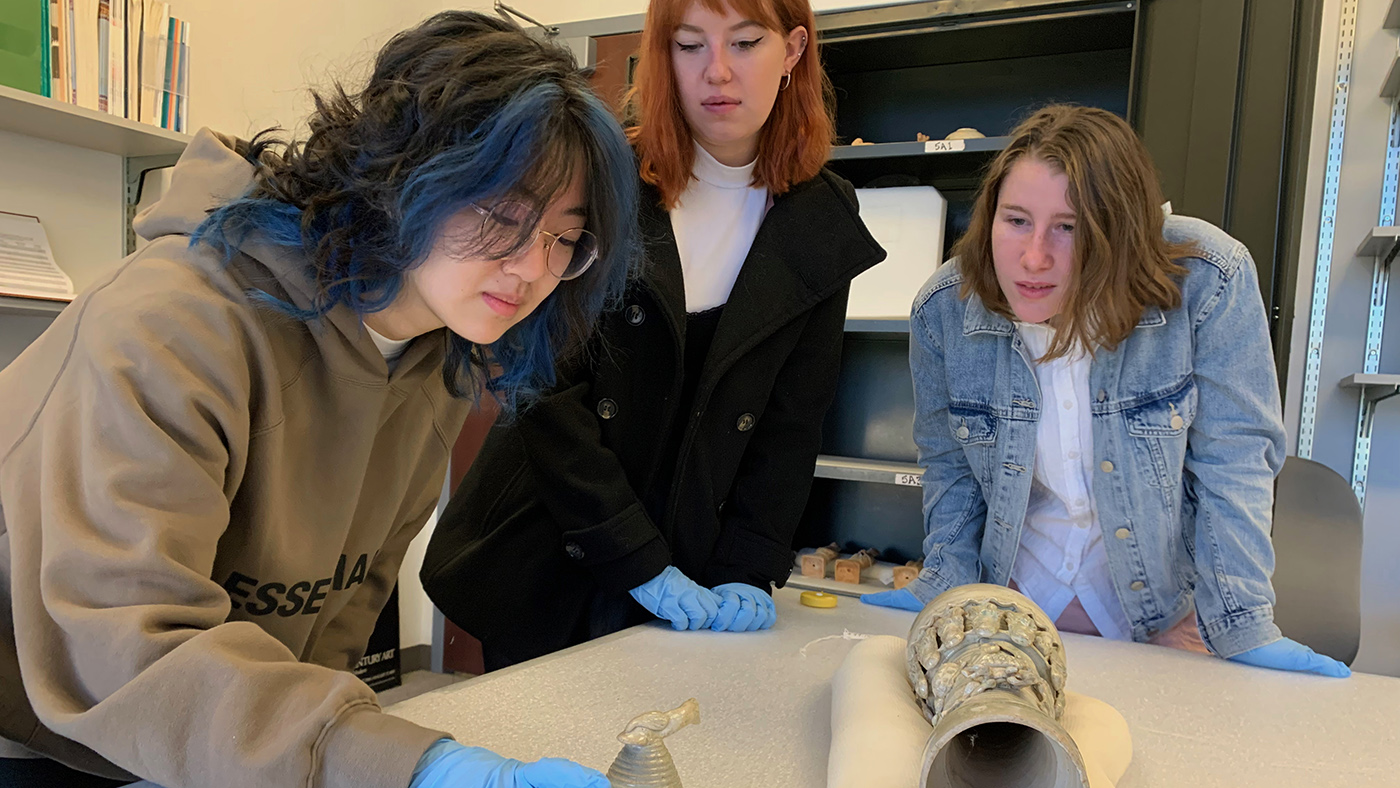Penn Museum’s Student-Curated Exhibition Illuminates Ancient Burial Practices in China, Opens March 30

PHILADELPHIA, February 19, 2024—Now in its 10th year, as a part of the Student Exhibitions program, three University of Pennsylvania undergraduate students curated Looking to the Stars, Listening to the Earth: Song Dynasty Tomb, which explores Chinese burial practices, including the use of Feng Shui principles. Showcasing burial artifacts in a way that demonstrates their archaeological context, the show will open to the public on Saturday, March 30, 2024.
Juniors Lianxun (Jasmine) Wang and Sarah Hinkel, along with senior Mackenzie McKillip, consulted with Museum departments including the Center for the Analysis of Archaeological Materials (CAAM), Conservation, and Public Programs, as they conducted research, selected a theme, and learned the process of launching an exhibition for the public.
The students’ focus was on a tomb from the Jiangxi region of southeastern China during the Song Dynasty (960-1279 CE)—a period of great cultural, artistic, and technological achievements, economic development, and population booms. Dating back to 1200 CE, the tomb sheds light on how people followed particular burial rituals, in which 12 directions and astronomical positions played an important role.
Looking to the Stars, Listening to the Earth illuminates burial preparations and the meaning behind arranging the tomb in a specific way using carefully placed objects, like ceramic vessels and figurines.
When families buried their loved ones during the Song Dynasty, they worked with geomancers (spiritual guides who used energy forces to harmonize individuals with their surroundings, a practice that is a part of Feng Shui) to select the location for the tombs. They also sourced figurines from local workshops and arranged the tomb’s contents according to sacred texts. These practices were believed to ensure safe passage into the afterlife and produce tangible benefits to descendants.
Lianxun (Jasmine) Wang, a Fine Arts major from Wuhan, China, says profound supernatural meanings and cultural systems guided these burial practices, which serve as foundational elements of Chinese culture.
“Growing up in China, I take great pride in my culture and look forward to sharing and explaining its richness,” Wang said. She adds that the figurine (Object: 80-5-19), which “gazes up toward the infinite cosmos,” especially resonated with her.
“It’s a reminder of human insignificance and the profound link that binds the transcendence of human existence to the ethereal realm of nature. It underscores the significance of astrology in the lives of people during the Song Dynasty. Their practice of observing the sky and constellations was a pivotal means of comprehending the world and guiding their daily actions.”
Another student curator, Sarah Hinkel, is majoring in Near Eastern Civilizations and Languages. She hails from Maytown, Pennsylvania, about 15 miles west of Lancaster. She says the figurines illustrate the beliefs behind burial preparations. Her favorite object in the display is a divinity figurine (Object: 80-5-13).
“In researching the figurines, it was fascinating to see evidence on their surfaces and through X-ray images,” Hinkel explains. “Manufacturing techniques may seem mundane, but it can reveal a lot about relationships between the objects and the economy at the time. In this case, it shows the importance of being able to make figurines for tombs efficiently and in large quantities to ensure people can easily and readily obtain these objects for their loved ones’ tombs.”
Looking to the Stars, Listening to the Earth also introduces material not excavated from the tomb, such as a compass from Vietnam, burial scriptures, and a Chinese fortune-telling manual.
Mackenzie McKillip, an Anthropology major from Wartrace, Tennessee, and also a curator, hopes that the exhibition will inspire visitors to think about the importance of space.
“The figures on display are perfect representations of careful and deliberate arrangement based on Song belief systems about the afterlife. So, the idea that things are in place because of a specific reason is vital, and carries on into everyday life, not just in a sacred tomb,” explains McKillip, who hopes to one day work with museums, cultural heritage protection, and education. “Museums and examining objects are crucial parts to fully understanding history.”
Looking to the Stars, Listening to the Earth: Song Dynasty Tomb is included with Museum admission and will remain on view through March 2025.
###
About the Penn Museum
The Penn Museum’s mission is to be a center for inquiry and the ongoing exploration of humanity for our University of Pennsylvania, regional, national, and global communities, following ethical standards and practices.
Through conducting research, stewarding collections, creating learning opportunities, sharing stories, and creating experiences that expand access to archaeology and anthropology, the Museum builds empathy and connections across diverse cultures
The Penn Museum is open Tuesday-Sunday, 10:00 am-5:00 pm. It is open until 8:00 pm on first Wednesdays of the month. The Café is open Tuesday-Thursday, 9:00 am-3:00 pm and Friday and Saturday, 10:00 am-3:00 pm. On Sundays, the Café is open 10:30 am-2:30 pm. For information, visit www.penn.museum, call 215.898.4000, or follow @PennMuseum on social media.
Through conducting research, stewarding collections, creating learning opportunities, sharing stories, and creating experiences that expand access to archaeology and anthropology, the Museum builds empathy and connections across diverse cultures.
Hero image is available for download here



